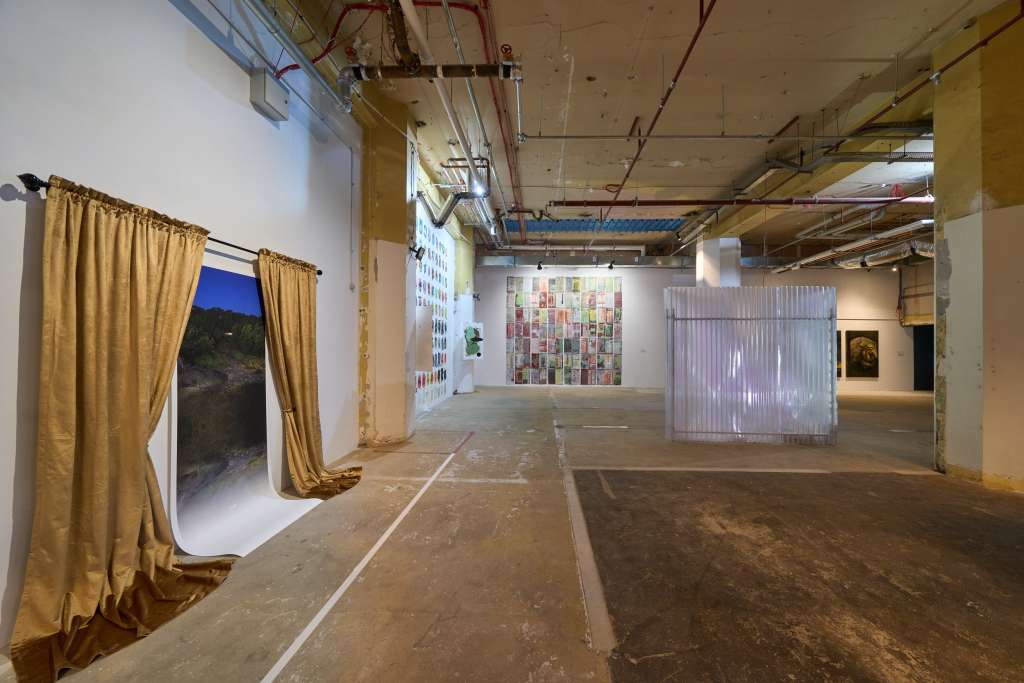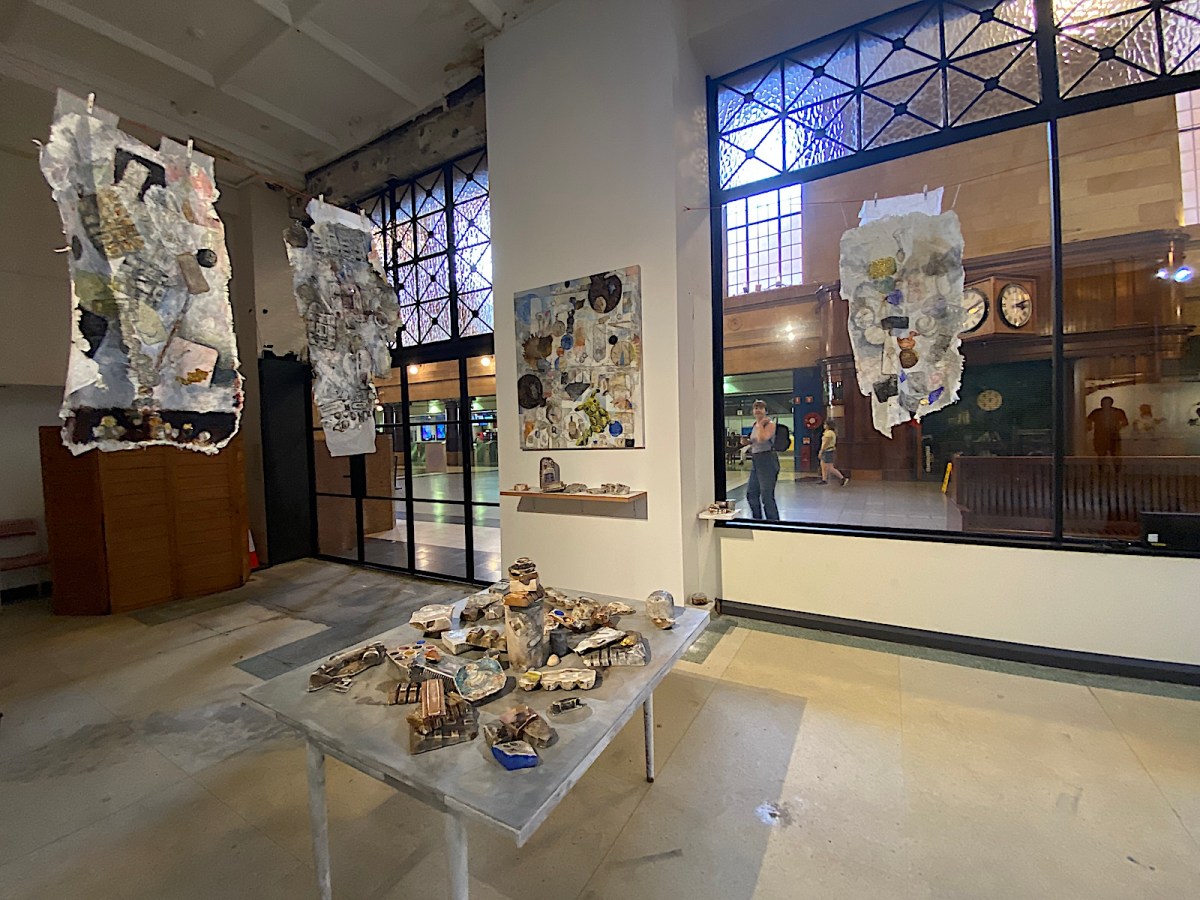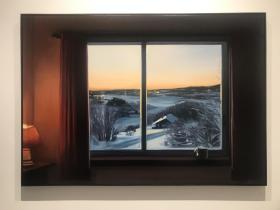Neoterica returns as the second iteration of a biennial exhibition at the Adelaide Festival, in a semi-industrial space in the Adelaide Railway Station with the support of Renewal SA, bringing together new works from 20 mid-career artists in South Australia, who have each been paired with a writer.
It is an artist-led initiative steered by Ray Harris, who tells ArtsHub: ‘I think emerging used to be the hole, and then that [gap] got all filled up. And it’s like you come out of there, and then what happens? Obviously, as an artist you need to exhibit.’ She adds that opportunities to show are often difficult to secure.
Neoterica offers that mid-career lens on making now. There is no theme pulling this disparate group of artists together, but that doesn’t impact the visitor experience.
The exhibition presents making currently – in all its concerns, individual expressions and sensitivities – across photography, painting, printmaking, performance, sculpture, installation, video, sound, ceramics and mixed media. Simply, it is a celebration of artists who call South Australia their home.
One of the first works encountered is Jenn Brazier’s photographic installation, Reverence (2024,) which comprises a scroll landscape that furls onto the ground, and is framed by gold curtains. It is an image of stunning bush, which has recently been deemed a conservation zone, and yet edges a power plant. The sense of peeling back and revealing a natural treasure is theatrically played out.
The gallery space is loosely divided into two zones, both with large windows onto the concourse of Adelaide Central Railway Station, allowing commuters to incidentally engage with the exhibition.
In one gallery, along with Brazier’s work, is a large polycarbonate structure by Matt Huppatz, which is illuminated from within and emanates a soundscape. It sits central to the space (not unlike a shipping container) and is an ambitious work by this mid-career artist, but reads largely as an abstract gesture.
Gesture, however, is confident in the works of two stacked grids of painterly studies, the first by Sue Ninham, which comprises 100 colourful A4 studies, and the second by Sam Howie. Of a similar scale, Howie’s surfaces are more worn with patina and are worked over with flowing gestural lines. They describe them as a distilled figure in the landscape.

Another highlight in this area are the quirky sculptures by Simone Kennedy, which seemingly climb a structural column, almost like barnacles. She calls them ‘knowledge sites’, and they have a wonderful energy and sense of free gesture and play.
In a central darkened gallery is the work of Deirdre Feeney, Hallway (2024), which blurs past and contemporary technologies with a “ye olde” feel. Three-dimensional printed resin elements replace slides in a carousel; the image they project is a ball rolling across a hallway and staircase. It feels familiar, it feels experimental and it promotes a certain wonder.
In the next gallery, highlights include a video montage work by Sarah Tickle titled Storm Centre (2024). A pair of screens sit abutted into a corner – one riffs off the filmic term “fridging”, used to justify the male rampage and toxic behaviour at the expense of the female character’s death. The second screen picks up the term “final girls”, another horror trope where the “last man standing” is a woman.
It is a fun and smart work by Tickle, which explores female roles nurtured through Western cinema, polarising the woman as both the most easily disposed of and the most valued and empowered.
Also turning to female tropes, Fran Callen’s suite of works explore motherhood and domestic routine. Her rich textured marks sit across unstretched canvases like skins or tablecloths, metaphorically diarising the mess and chaos of family life. Callen is interested in geology, and explores that bedrock from a foundation of household recycling to time-based layering in her art objects.
Family is also key in the work of Sonja Porcaro, which sits within easy view of Callen’s work, picking up similar ideas of the family home. But rather working from a lived experience, Porcaro nods to the journey of migration of her Italian father, who moved to Australia aged 10. His lodgings’ rules stated: ‘No Italians, No Children, No Dogs.’
Porcaro’s installation Il Passaggio/Passage (2023-24) is an homage to the passage of arrival and departure, and the embedded emotions of hope and trepidation. She has created beautiful delicate forms from wire mesh, that sit atop fine pine custom stands, and balance coloured spools of cotton – all skills inherited from her parents, and speaking to notions of stitching memory and knowledge across time and place.
Read: Performance reviews: Marina Abramović Institute: Takeover, Adelaide Festival
The raw, semi-industrial space is amazing, and these artists really demonstrate its potential. While there are a number of artist-run spaces in Adelaide, it is believed that use of this space is unlikely to continue to be available to artists.
Be sure to get along and see (and support) this project – it really is a credit to all the artists involved. And the closing event will coincide with performances and artist talks.
Neoterica
North Eastern Concourse, Adelaide Railway Station
1 March – 14 April
Curator: Ray Harris
Free.
Artists: Eleanor Alice, Jenn Brazier, Fran Callen, Makeda Duong, Deirdre Feeney, Keith Giles, Gail Hocking, Sam Howie, Matt Huppatz, Simone Kennedy, Bernadette Klavins, Kate Kurucz, Tristan Louth-Robins, Riza Manalo, Sue Ninham, Sonja Porcaro, Jess Taylor, Cassie Thring, Sarah Tickle, and Raymond Zada.
Featured writers: Lilla Berry, Nic Brown, Quentin Brown, Nicole Clift, Melanie Cooper, Jennifer Eadie, Piri Eddy, Caitlin Eyre, Maire Falcinella, Paul Gazzola, Sasha Grbich, Tegan Hale, Alysha Herrmann, Denise Nolasco, Anisha Pillarisetty, Meg Riley, Eleanor Scicchitano, Kathie Stove, Ash Tower and Aushaf Widisto.
This exhibition is part of 2024 Adelaide Festival programming. The writer travelled to Adelaide as a guest of the festival.





